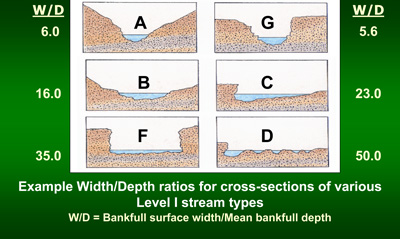Width/Depth Ratio
The width/depth (W/D) ratio is defined as the ratio of the bankfull surface width to the mean depth of the bankfull channel. The width/depth ratio is key to understanding the distribution of available energy within a channel, and the ability of various discharges occurring within the channel to move sediment. Of the Level II criteria, the W/D ratio is the most sensitive and positive indicator of trends in channel instability. Determination of the width/depth ratio provides a rapid, visual assessment of channel stability.
Measurement of the width/depth ratio is also valuable for describing channel cross-section shape and comparison of ratio values can be used to interpret shifts in channel stability following disturbances to channels or watersheds. Osterkamp et al. (1983) derived power functions used to predict streamflow using W/D ratios as a surrogate for channel sediment characteristics and the distribution of shear stress. Osborn and Stypula (1987) used W/D ratios to characterize channel hydraulics by describing channel boundary shear as a function of channel shape.
The distribution of energy within channels having high W/D ratios (i.e., shallow and wide channels) is such that stress is placed within the near bank region. As the W/D ratio value increases (i.e, the channel grows wider and more shallow), the hydraulic stress against the banks also increases and bank erosion is accelerated. The accelerated erosion process is generally the result of high velocity gradients and high boundary stress, as mean velocity, stream power, and shear stress decrease in the presence of an increase in width/depth ratio values. Increases in the sediment supply to the channel develop from bank erosion, which - by virtue of becoming an over widened channel - gradually loses its capability to transport sediment. Deposition occurs, further accelerating bank erosion, and the cycle continues.
For all stream types except multiple thread channel, a W/D ratio of 12 is the high end value for "A," "G," and "E" stream types and the low end value for "B," "C," and "F" stream types. Analyses of field data showed a width/depth ratio continuum value of 10, but a ratio value of 12 was selected as the most frequently observed value. The W/D ratio value of 12 is empirically derived, but is related to physical processes governing the distribution of energy and resultant sediment transport. Channel dimension, pattern, profile, and corresponding stream types change when the width/depth ratio is significantly altered.
Width/depth ratios should be determined on selected reference reaches using the same criteria for determining bankfull stage indicators and bankfull channel measurements. That is, the selected reach should be free to adjust its boundaries in response to frequent flows and should not have excessive deposition, nor constrictions. Wherever possible, at least one or more permanent cross-section should be established to permit resurveying so that changes in state or stability of a stream may be effectively determined. Permanent benchmarks for use as reference elevations can be installed using either cemented or driven metal rods. Width/depth ratios are determined from measured channel cross-sections.
![[logo] US EPA](https://www.epa.gov/epafiles/images/logo_epaseal.gif)
